
Photo from wikipedia
An important characterization of electromagnetic and weak transitions in atomic nuclei are sum rules. We focus on the non-energy-weighted sum rule (NEWSR), or total strength, and the energy-weighted sum rule… Click to show full abstract
An important characterization of electromagnetic and weak transitions in atomic nuclei are sum rules. We focus on the non-energy-weighted sum rule (NEWSR), or total strength, and the energy-weighted sum rule (EWSR); the ratio of the EWSR to the NEWSR is the centroid or average energy of transition strengths from an nuclear initial state to all allowed final states. These sum rules can be expressed as expectation values of operators, in the case of the EWSR a double commutator. While most prior applications of the double-commutator have been to special cases, we derive general formulas for matrix elements of both operators in a shell model framework (occupation space), given the input matrix elements for the nuclear Hamiltonian and for the transition operator. With these new formulas, we easily evaluate centroids of transition strength functions, with no need to calculate daughter states. We apply this simple tool to a number of nuclides, and demonstrate the sum rules follow smooth secular behavior as a function of initial energy, as well as compare the electric dipole (E1) sum rule against the famous Thomas-Reiche-Kuhn version. We also find surprising systematic behaviors for ground state electric quadrupole (E2) centroids in the $sd$-shell.
Journal Title: Physical Review C
Year Published: 2018
Link to full text (if available)
Share on Social Media: Sign Up to like & get
recommendations!